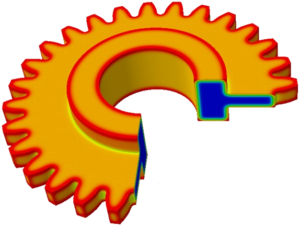
DANTE can model most case hardening, thermal, and quench hardening processes. Some case hardening processes include low pressure and gas carburization, gas nitriding, induction, flame, and laser hardening. Quench hardening processes such as immersion into oil, water, or polymer, high pressure gas quenching, press/fixture quenching, and spray quenching. Some other processes that can be modeled include cryogenic treatment, tempering, precipitation hardening, martempering, austempering, normalizing, and annealing. This is not an exhaustive list, so if you have a process that is not listed, contact us. We love to model new and interesting process.
No. Analytical phase transformation models are applied in DANTE instead of TTT/CCT phase diagrams because the application of the TTT/CCT phase diagrams are limited. TTT/CCT diagrams can only describe the transformation timing, whereas the transformation timing and transformation strains are required to properly model the stress state of the part. Strengths of the DANTE phase transformation models are listed below:
One strength in DANTE is its multiple phase mechanical model. The internal state variable (ISV) mechanical model is implemented in DANTE instead of a traditional constitutive model based on effective strain.
The heat treatment process includes stress reversals due to thermal gradients and phase transformations, and these strain reversals make the traditional constitutive model ineffective. The temperature of the part continually changes during the heat treatment process, and the strain generated in the material at one temperature has a significant effect on stress at another temperature, which also makes the traditional constitutive model ineffective.
To have a proper heat treatment simulation model, material properties spanning several phenomena are needed.
A standard material database is included with the DANTE software package. The database includes most standard U.S. steel grades.
The database includes materials such as 10XX, 40XX, 41XX, 43XX, 48XX, 51XX, 86XX, 93XX, 52100, 304SS, and many more. The “XX” in the grades indicate there are properties for multiple carbon levels, allowing for the modeling of a carburized component.
DANTE also includes a user material database where users can add additional materials to suit their needs. DANTE Solutions has developed utility programs to facilitate the fitting of experimental data to the DANTE heat treatment simulation models.
Yes. Experiments will be needed to characterize the phase transformation kinetics, mechanical properties, and thermal properties for heat treatment simulation. The extent of the experiments will be determined by several factors:
Several different types of experiments are required to properly and fully characterize a material for heat treatment simulation. DANTE Solutions has characterized many materials over the years, and can help you design the experiments, as well as the necessary coupons, to characterize your material for the DANTE material database. Below is a quick description of the types of experiments and coupons utilized for particular parameters:
Yes. The format is determined by either ANSYS or ABAQUS, depending on which solver you are using in conjunction with DANTE. We have used Joule heating as a function of time from several different electromagnetic modeling software packages and stress profiles from forming and casting softwares.
DANTE results can also be used as inputs or initial conditions to other models. Most common is the use of the residual stress from heat treatment as an initial condition to loading or fatigue models. The format again is determined by the FE solver being used for the loading or fatigue models. The version of DANTE linking to ANSYS includes a convenient post processing tool that allows for the generation of a file that writes the residual stress tensor as a function of Cartesian coordinates to a text file, which is then read back into ANSYS Mechanical for loading models.
Yes. There are several methods which can be used to model induction hardening with the DANTE Heat Treatment Simulation software.
Yes. The phase transformation models can properly account for the transition of martensite to tempered martensite. The mechanical model can account for the mechanical property differences between martensite and tempered martensite. The mechanical model can also account for the relaxation of residual stress as carbides precipitate out of the martensite matrix.
High temperature tempering is now also available in DANTE. This model works well for secondary hardening steels, as well as a model for the fast heating rate, short time induction tempering process. These models also account for volume shrinkage seen at tempering temperatures above 300 degrees Celsius.
Understanding the heat treatment process being modeled is of critical importance. Although the material properties determine the material response to a given treatment, describing the given treatment in terms of boundary conditions drives the heat treatment simulation response. The most critical piece of processing data needed is not given on a machine display, but must be determined from experiments for the greatest level of accuracy: The thermal boundary condition. The most common form of a thermal boundary condition is expressed as a heat transfer coefficient (HTC). The HTC can be determined from solving the inverse heat transfer problem using a finite element model and experimental data. Other important process data is temperatures and times for each step of the process. All of this data must be known, or determined, for each of the processing steps; preheat, austenitizing, quenching, deep freezing, tempering, and any transfers involved.

Home of The Heat Treatment Simulation Software
Dante Solutions © 2024 All rights reserved